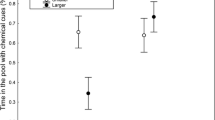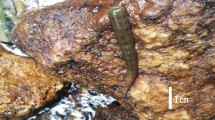Abstract
The red-eared slider (Trachemys scripta elegans) is an introduced invasive species in many Mediterranean countries that is displacing the populations of native endangered Spanish terrapins (Mauremys leprosa). However, it is relatively unknown how potential competitive interactions could be taking place. In many freshwater turtles, semiochemicals from different glands might facilitate species and sex recognition. We hypothesized that chemosensory detection of competitor species might affect space use and habitat selection by freshwater turtles. We analyzed whether T. scripta and M. leprosa turtles recognized chemical cues from male and female conspecifics and heterospecifics in water. We compared time spent by turtles in clean water pools vs. water pools containing the different chemical stimuli. Introduced T. scripta did not avoid nor prefer water pools with chemical stimuli of native M. leprosa terrapins, which might favor the expansion of the invasive species. In contrast, M. leprosa preferred water with chemical stimuli of conspecifics and avoided water with chemical cues of T. scripta, which suggests that chemical cues could be used by native M. leprosa to avoid water pools occupied by introduced T. scripta. We suggest that this avoidance behavior of native M. leprosa may be one of the causes that contribute to the observed displacement of their populations by invasive T. scripta.



Similar content being viewed by others
References
Amo L, López P, Martín J (2004) Wall lizards combine chemical and visual cues of ambush snake predators to avoid overestimating risk inside refuges. Anim Behav 67:647–653
Auffenberg W (1966) On the courtship of Gopherus polyphemus. Herpetologica 22:113–117
Boycott BB, Guillery RW (1962) Olfactory and visual learning in the red-eared terrapin, Pseudemys scripta elegans (Wied). J Exp Biol 39:567–577
Cadi A, Joly P (2003) Competition for basking places between the endangered European pond turtle (Emys orbicularis galloitalica) and the introduced red-eared slider (Trachemys scripta elegans). Can J Zool 81:1392–1398
Cadi A, Joly P (2004) Impact of the introduction of the red-eared slider (Trachemys scripta elegans) on survival rates of the European pond turtle (Emys orbicularis). Biodiv Conserv 13:2511–2518
Cagle FR (1950) The life history of the slider turtle, Pseudemys scripta troostii (Holbrook). Ecol Monogr 20:31–54
Chivers DP, Smith RJF (1995) Free-living fathead minnows rapidly learn to recognize pike as predators. J Fish Biol 46:949–954
Chivers DP, Smith RJF (1998) Chemical alarm signalling in aquatic predator/prey systems: a review and prospectus. Ecoscience 5:338–352
Chivers DP, Wildy EL, Kiesecker JM, Blaustein AR (2001) Avoidance response of juvenile Pacific treefrogs to chemical cues of introduced predatory bullfrogs. J Chem Ecol 27:1667–1676
Da Silva E, Blasco M (1995) Trachemys scripta elegans in Southwestern Spain. Herpetol Rev 26:133–134
De-Rosa CT, Taylor DH (1980) Homeward orientation mechanism in three species of turtles (Trionyx spinifer, Chysemys picta, and Terrapene carolina). Behav Ecol Sociobiol 7:15–23
Díaz-Paniagua C, Marco A, Andreu AC, Sánchez C, Peña L, Acosta M, Molina I (2002) Trachemys scripta en Doñana. Unpublished report, AHE
Dodson SI, Crowl TA, Peckarsky BL, Covich AP, Culp JM (1994) Non-visual communication in freshwater benthos: an overview. J North Am Benthol Soc 13:268–282
Downes S (2002) Does responsiveness to predator scents affect lizard survivorship? Behav Ecol Sociobiol 52:38–42
Ehrenfeld JG, Ehrenfeld DW (1973) Externally secreting glands of freshwater and sea turtles. Copeia 1973:305–314
Ernst CH (1971) Observations of the painted turtle, Chrysemys picta. J Herpetol 5:216–220
Evans LT (1952) Endocrine relationship in turtles, III. Some effects of male hormones in turtles. Herpetologica 8:11–14
Gibbons JW, Greene JL (1990) Reproduction in the slider and other species of turtles. In: Gibbons WJ (ed) Life history and ecology of the slider turtle. Smithsonian Institution Press, Washington DC, pp 124–134
Graham T, Georges A, McElhinney N (1996) Terrestrial orientation by the eastern longnecked turtle, Chelodina longicollis, from Australia. J Herpetol 30:467–477
Halpern M (1992) Nasal chemical senses in reptiles: structure and function. In: Gans C, Crews D (eds) Biology of the reptilia. Brain, hormones, and behavior, vol 18. University of Chicago Press, Chicago, pp 423–522
Harless M (1979) Social behavior. In: Harless M, Morlock H (eds) Turtles. Perspectives and research. Wiley, New York, pp 475–492
Hatanaka T, Matsuzaki O (1993) Odor responses of the vomeronasal system in Reeve’s turtle Geoclemys reevesii. Brain Behav Evol 23:183–186
Jackson JF (1990) Evidence for chemosensory-mediated predator avoidance in musk turtles. Copeia 1990:557–560
Jackson CG Jr, Davis JD (1972) A quantitative study of the courtship display of the red-eared turtle, Chrysemys scripta elegans (Wied). Herpetologica 28:58–63
Kats LB, Dill LM (1998) The scent of death: chemosensory assessment of predation risk by prey animals. Ecoscience 5:361–394
Kaufmann JH (1992) The social behavior of wood turtles, Clemmys insculpta, in central Pennsylvania. Herpetol Monogr 6:1–25
Kramer M, Fritz U (1989) Courtship of the turtle, Pseudemys nelsoni. J Herpetol 23:84–86
Legler JM (1993) Morphology and physiology of the Chelonia. In: Glasby CJ, Ross GJB, Beesley PL (eds) Fauna of Australia, vol 2A. Amphibia and reptilia. Australian Government Publishing Service, Canberra, pp 108–119
Luiselli L, Capula M, Capizzi D, Filippi E, Trujillo JV, Anibaldi C (1997) Problems for conservation of pond turtles (Emys orbicularis) in central Italy: is the introduced red-eared turtle (Trachemys scripta) a serious threat? Chelonian Conserv Biol 2:417–419
Magurran AE (1989) Acquired recognition of predator odour in the European minnow (Phoxinus phoxinus). Ethology 82:216–223
Mason RT (1992) Reptilian pheromones. In: Gans C, Crews D (eds) Biology of the reptilia, vol 18. University of Chicago Press, Chicago, pp 114–228
Mathis A, Chivers DP, Smith RJF (1996) Cultural transmission of predator recognition in fishes: intraspecific and interspecific learning. Anim Behav 51:185–201
Müller-Schwarze D (2006) Chemical ecology of vertebrates. Cambridge University Press, Cambridge
Muñoz A (2004) Chemo-orientation using conspecific chemical cues in the stripe-necked terrapin (Mauremys leprosa). J Chem Ecol 30:519–530
Parmenter RR (1980) Effects of food availability and water temperature on the feeding ecology of pond sliders (Chrysemys s. scripta). Copeia 1980:503–514
Patterson R (1971) Aggregation and dispersal behavior in captive Gopherus agassizi. J Herpetol 5:214–216
Pleguezuelos JM (2002) Las especies introducidas de Anfibios y Reptiles. In: Pleguezuelos JM, Márquez R, Lizana M (eds) Atlas y Libro Rojo de los Anfibios y Reptiles de España. AHE-MMA, Madrid, pp 501–532
Pleguezuelos JM, Márquez R, Lizana M (2002) Atlas y Libro Rojo de los Anfibios y Reptiles de España. AHE-MMA, Madrid
Polo-Cavia N, López P, Martín J (2008) Interspecific differences in responses to predation risk may confer competitive advantages to invasive freshwater turtle species. Ethology 114:115–123
Poshcadel JR, Meyer-Lucht Y, Plath M (2006) Response to chemical cues from conspecifics reflects male mating preference for large females and avoidance of large competitors in the European pond turtle, Emys orbicularis. Behaviour 143:569–587
Quinn VS, Graves BM (1998) Home pond discrimination using chemical cues in Chrysemys picta. J Herpetol 32:457–461
Rose FL, Drotman RB, Weaver WG (1969) Electrophoresis of chin gland extracts of Gopherus (tortoises). Comp Biochem Physiol 29:847–851
Scott TR (1979) The chemical senses. In: Harless M, Morlock H (eds) Turtles. Perspectives and research. Wiley, New York, pp 267–287
Seigel RA (1980) Courtship and mating behavior of the diamondback terrapin, Malaclemys terrapin tequesta. J Herpetol 14:420–421
Shigesada N, Kawasaki K (1997) Biological invasions: theory and practice. Oxford University Press, Oxford, UK
Simeonovska-Nikolova DM (2007) Interspecific social interactions and behavioral responses of Apodemus agrarius and Apodemus flavicollis to conspecific and heterospecific odors. J Ethol 25:41–48
Sokal RR, Rohlf FJ (1995) Biometry, 3rd edn. WH Freeman, New York
Solomon SE (1984) The characterisation and distribution of cells lining the axilary gland of the adult green turtle (Chelonia mydas L.). J Anat 138:267–279
Walker WF (1959) Closure of the nostrils in the Atlantic loggerhead and other sea turtles. Copeia 1959:257–259
Wilcove DS, Rothstein D, Dubow D, Phillips A, Losos E (1998) Quantifying threats to imperiled species in the United States. Bioscience 48:607–615
Williamson M (1996) Biological invasions. Chapman and Hall, London
Winokur RM, Legler JM (1975) Chelonian mental glands. J Morphol 147:275–292
Acknowledgments
We thank an anonymous reviewer for helpful comments, the “Grupo de Rehabilitación de la Fauna Autóctona y su Hábitat” (GREFA) for providing sliders, and “El Ventorrillo” MNCN Field Station for use of their facilities. Financial support was provided by the Ministerio de Educación y Ciencia project CGL2005-00391/BOS, and by an “El Ventorrillo” C.S.I.C. grant and a Ministerio de Educación y Ciencia FPU grant to N. P.-C. The experiments enforced all the present Spanish laws and of the Environmental Organisms of Madrid Communities where they were carried out.
Author information
Authors and Affiliations
Corresponding author
Rights and permissions
About this article
Cite this article
Polo-Cavia, N., López, P. & Martín, J. Interspecific differences in chemosensory responses of freshwater turtles: consequences for competition between native and invasive species. Biol Invasions 11, 431–440 (2009). https://doi.org/10.1007/s10530-008-9260-z
Received:
Accepted:
Published:
Issue Date:
DOI: https://doi.org/10.1007/s10530-008-9260-z




